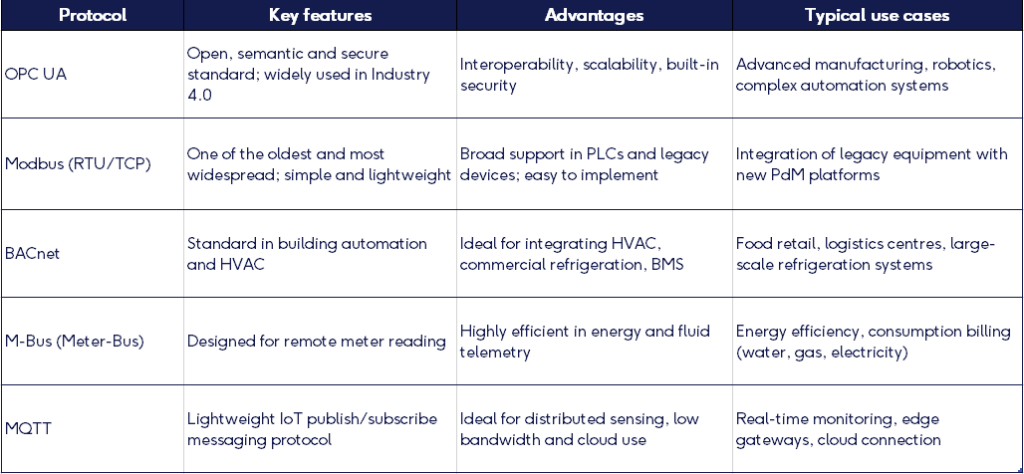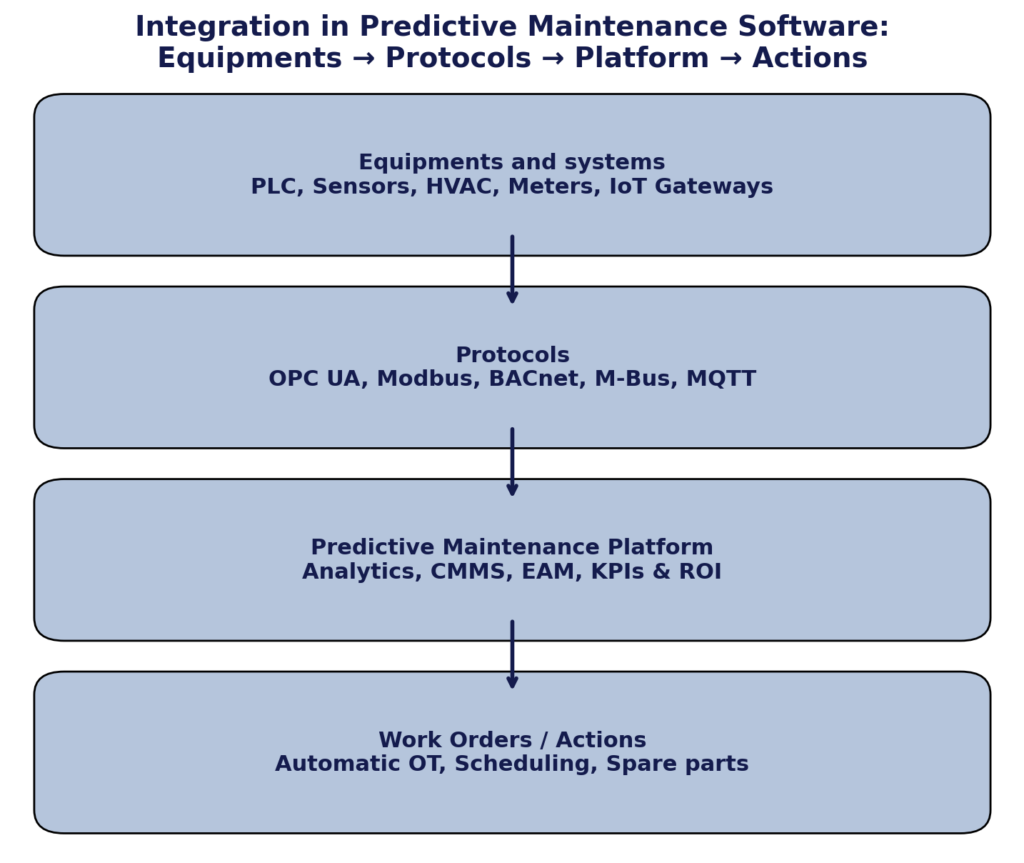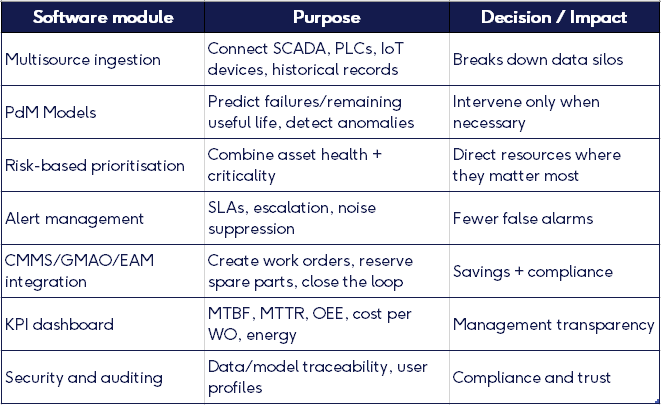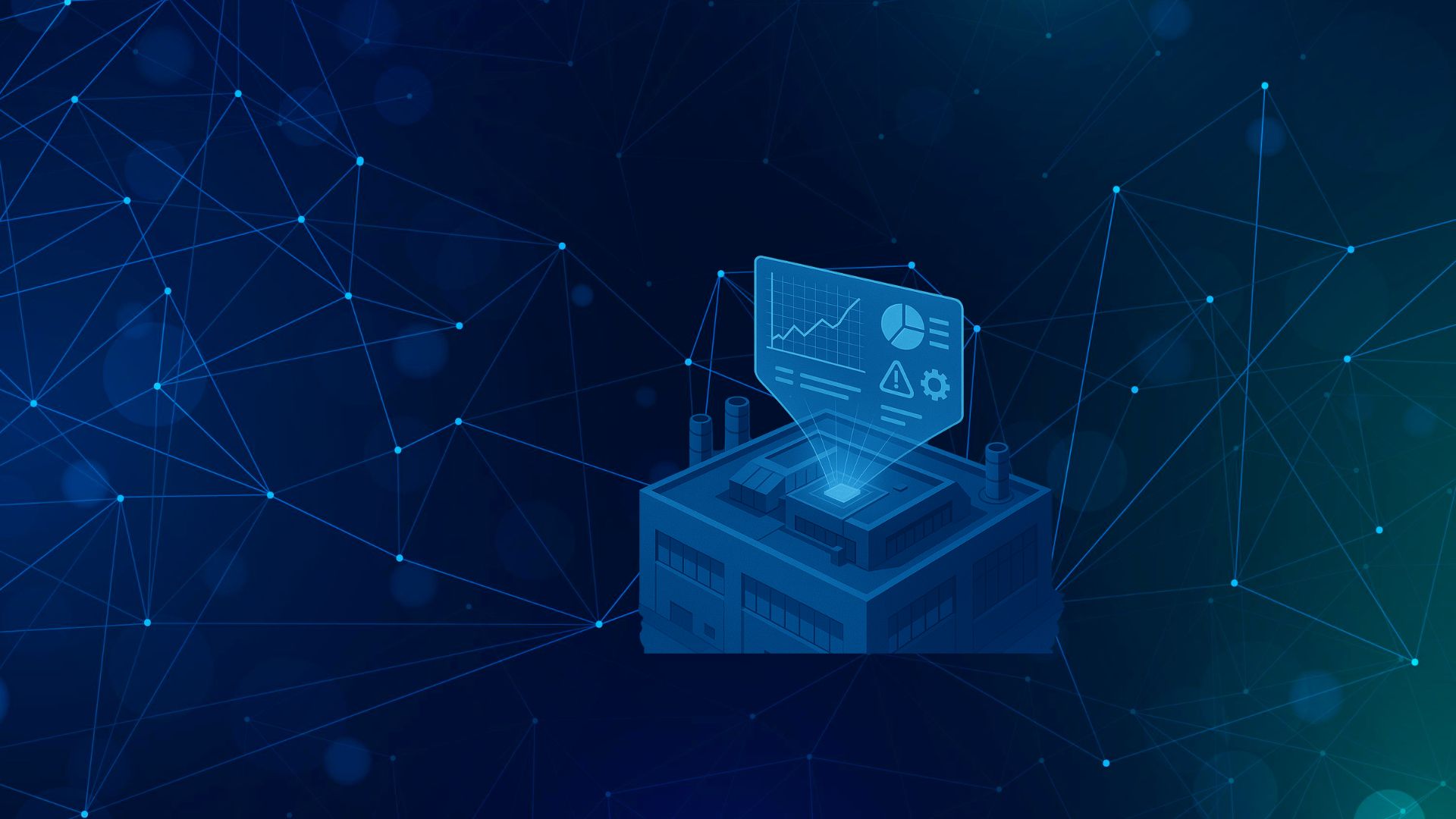In industries such as food, logistics and retail, every minute of downtime in a refrigeration system, a freezing tunnel or a industrial production line can result in millions in losses. A failure in the cold chain, an unexpected stop in a freezing tunnel, or a malfunction in warehouse climate control can compromise both food safety and customer trust. Predictive maintenance software (also referred to as predictive maintenance solutions or PdM software) has become a strategic tool to anticipate failures and plan interventions with maximum efficiency.
Today this approach is no longer reserved for large corporations. Thanks to cloud architectures and IoT integration, even mid-sized companies can now access custom software for predictive maintenance to increase competitiveness and reduce operational risks.
What predictive maintenance software is (and isn’t)
Predictive maintenance software (also referred to as PdM software or predictive maintenance solutions) brings together data capture (sensors, SCADA/IoT), analytics (condition and failure models), execution (alerts, prioritisation, work orders) and operational integration (CMMS/EAM/ERP).
It builds on ISO 17359 guidelines for condition monitoring (vibration, temperature, pressure, etc.) to turn signals into diagnostics and planned actions.
It is not the same as:
- CMMS/EAM: transactional backbone for assets, plans, work orders and spares. The predictive layer feeds it with signals and recommendations and may create/synchronise WOs.
- IoT/SCADA platforms: focus on data acquisition/visualisation; the predictive module outputs predictions and decisions (anomalies, RUL, severity).
- Enterprise Asset Management (EAM): strategic/financial view of asset lifecycle; the predictive layer adds risk and asset health to prioritise investments, aligned with ISO 55000.
For a broader overview of maintenance types (corrective, preventive, predictive), see our article on types of industrial maintenance.
Reference architecture: from sensor to work order
A predictive maintenance solution is not just an algorithm: it requires a robust architecture that ensures data flows from the sensor to the executed work order.
The reference architecture typically consists of several layers:
- Acquisition layer: field devices (temperature, vibration, energy and pressure sensors), PLCs and SCADA systems, supported by edge gateways for preprocessing.
- Communication and protocols: interoperability requires support for OPC UA, Modbus, and, in retail and commercial refrigeration, BACnet and M-Bus.
- Ingestion and normalisation: OPC UA, MQTT and API connectors, with data cleaning, time synchronisation and feature engineering.
- Monitoring and historicals: either in SCADA/historians or in the PdM software itself. Many predictive maintenance solutions now integrate their own historian modules.
- Analytics and predictive models: anomaly detection, Remaining Useful Life (RUL) estimation, machine learning and deep learning models.
- Operational management: where predictions are converted into actions. Three models exist:
- Integration with CMMS/EAM (most common in large companies).
- Direct execution in PdM software (all-in-one predictive maintenance solutions).
- Hybrid coexistence PdM software ↔ CMMS (automatic OT execution + registration in CMMS as system of record).
- Governance and security: MLOps, data lineage, OT cybersecurity under IEC 62443, and compliance with ISO 17359 and ISO 55000.
Predictive maintenance software is not a “black box of AI” but a structured chain, where every layer — sensor, protocol, analytics, management and security — is critical to closing the loop: data → prediction → work order → action.
When predictive maintenance solutions also include monitoring and historical data, the reference architecture should reflect this as an optional layer within the PdM software. The choice depends on the organisation’s level of digital maturity.
Similarly, an all-in-one PdM software can coexist with a CMMS, provided the roles of each system are clearly defined: the PdM layer provides early detection and automatic work order generation, while the CMMS remains the central repository for assets, spares and preventive plans.
In both cases, coexistence between PdM software and existing systems (SCADA or CMMS) is only successful if supported by robust integrations and clearly defined boundaries. This prevents duplication of information — whether signal histories or work order records — and ensures data remains consistent and accessible.
Protocol comparison table
Visual integration software
The logic of this architecture is easier to grasp if you first understand how predictive maintenance programmes are defined and managed in general. You can explore this further in our dedicated article on predictive maintenance.
Key functionalities (must-have features)
Beyond architecture, a predictive maintenance solution must deliver functionalities that convert data into actionable value:
- Multisource ingestion: connectivity to SCADA, PLC, IoT devices and historical records, eliminating data silos.
- Predictive models: anomaly detection, RUL estimation and fault classification, enabling interventions only when necessary.
- Risk-based prioritisation: combining asset health with process criticality to direct maintenance resources where downtime would have the greatest impact.
- Smart alerts: reducing false positives, managing SLAs and escalation rules to keep maintenance teams focused on critical issues.
- Work order management: depending on the architecture, work orders may be created in the CMMS, executed autonomously in PdM software, or synchronised in a hybrid model.
- KPI dashboards: MTBF, MTTR, OEE and energy savings, providing management with objective performance indicators.
- Security and auditability: full traceability of data, predictive models and interventions for compliance and audits.
These are the differentiators between a monitoring tool and the best predictive maintenance software, capable of delivering measurable savings and competitive advantage.
Integration with advanced analytics and artificial intelligence
The value of a predictive maintenance solution does not depend solely on sensors, but on its analytical capabilities. Here it is useful to distinguish between three levels of analysis:
- Descriptive analytics: what happened and how often.
- Predictive analytics: when and how a failure is expected to occur (machine learning, degradation models).
- Prescriptive analytics: what to do, when to act and with which resources to minimise impact.
A robust system should evolve towards prescriptive capabilities, integrating supervised and unsupervised machine learning, deep learning algorithms for vibration or image analysis, and reinforcement learning for dynamic operating scenarios. This shift enables the move from simply “predicting failures” to scientifically optimising maintenance decisions in a replicable way.
KPIs and ROI (what to measure to make it count) in predictive maintenance software
Operational KPIs: MTBF, MTTR, OEE, spare parts lead time, false alarm rate, plan compliance, % of automatic work orders generated by the PdM engine.
Economic KPIs: maintenance cost per unit produced, energy savings, avoided downtime cost (£/hour × hours avoided), extended asset lifetime.
Simplified ROI formula:
ROI = (Direct savings + Avoided costs + Value of extended lifetime − Total cost [CAPEX + OPEX]) ÷ Total cost
Example of ROI
According to PwC – Predictive Maintenance 4.0, a structured predictive maintenance programme can reduce maintenance costs by 25–30%, cut downtime by 70%, and increase production by 20–25%.
How to select the right platform (executive checklist)
Choosing predictive maintenance software is not only about technical features, but about how well the solution fits the reality of your business: its digital maturity, the size of operations, regulatory requirements and overall technology strategy. This executive checklist provides clear decision criteria:
Strategy and fit
- Use cases anchored to the P&L (downtime, waste, energy).
- Scalability roadmap (from pilot to multi-site deployment).
- Digital maturity level of the organisation:
- Low maturity → all-in-one solutions with integrated monitoring and work order management.
- High maturity → integration with existing SCADA and CMMS, avoiding duplication.
- Plant size and complexity: simplicity for mid-scale facilities, robust interoperability for multi-plant or multi-sector environments.
Technology
- Industrial connectivity (OPC UA, APIs), edge computing and hybrid cloud.
- Predictive maintenance tools with model management (versioning, drift detection, retraining).
- Interoperability without vendor lock-in (data/model export).
- Scalability towards prescriptive maintenance (Industry 5.0): ability to expand across assets, data and algorithms without redesigning the architecture.
Operations and security
- Proven integration with CMMS/EAM, or autonomous PdM execution of work orders by the PdM platform (depending on chosen model: integrated, stand-alone or hybrid coexistence).
- IEC 62443 controls and IT/OT segregation.
- Evidence of data lineage and auditability.
- Regulatory compliance (ISO 55000, ISO 17359, sector standards like FDA, IFS or BRC).
People and change
- Training for technicians and analysts.
- Playbooks for alerts (who does what, how fast).
- 24/7 support and SLAs on model precision and latency.
- Alignment with corporate IT/OT strategy: consolidate existing ecosystems or simplify around PdM software?
At this stage it is also worth evaluating whether custom software for predictive maintenance is required to adapt to sector-specific needs.
Implementation in 90–180 days: from pilot to scale
Before launching, the organisation should decide its architectural model (integrated, autonomous or hybrid) and which system will serve as the official record of assets and work orders.
Phases:
- Assessment (2–4 weeks): data quality, asset criticality, connectivity testing (OPC UA, APIs, MQTT).
- Pilot (8–10 weeks): 1–2 lines or systems, validating predictive models, false positive rates and work order flows.
- Hardening (8–12 weeks): cybersecurity, model retraining, reconciliation with CMMS/SCADA.
- Scale-up: multi-plant deployment with governance (MLOps + audit).
If you are looking for a comprehensive methodological guide, see our article on the Predictive maintenance plan in Industry 4.0.
Costs, licensing and risks (and mitigation)
Costs
- CAPEX: sensors/gateways, system integration.
- OPEX: SaaS subscriptions, storage and compute, support, training.
- Other costs: ad-hoc connectors, historical data cleansing, OT network reinforcement.
Typical risks (and mitigation measures)
- Noisy data / unstable models → quality controls, periodic retraining, drift monitoring.
- False positives → dynamic thresholds + operational validation.
- Vendor lock-in → contracts with data/model portability clauses; open APIs.
- OT cyberattacks → network segmentation, hardening and IEC 62443 compliance.
Differentiators that truly make an impact
- Business risk prioritisation (not just technical asset health).
- Explainable AI: alerts presented with understandable reasons for technicians.
- Seamless integration with procurement and spare parts (to avoid critical stockouts).
- Digital twins for “what-if” scenarios (maintenance versus production).
- Traceability and auditability for food quality and safety compliance (Regulation 852/2004).
These are the capabilities that define the best predictive maintenance software in the market.
All of these differentiators take on greater significance within the broader context of digital transformation. Discover more in our article on Smart factories and industrial maintenance.
Emerging trends in predictive maintenance software
The evolution of this market is pointing towards:
- Generative AI applied to maintenance: automatic generation of fault hypotheses and recommendations in natural language.
- Enhanced digital twins: advanced simulation of operating and maintenance scenarios to support complex decision-making.
- Vertical platforms: sector-specific solutions (food, retail, oil & gas) with pre-trained model libraries.
- Collaborative cloud-based maintenance: sharing condition data and models between manufacturers, service providers and end-users.
These trends do not replace the current state of the art; they extend the horizon of predictive maintenance software, adding value to each decision and fostering cross-functional collaboration.
The World Economic Forum highlights how the Industrial IoT is redefining maintenance processes, positioning predictive maintenance as a strategic component of Industry 4.0 and industrial digitalisation (WEF – Industrial Internet of Things).
Conclusion: from models to measurable results with predictive maintenance software
Adopting predictive maintenance software means moving from simply “seeing data” to making repeatable decisions that prevent downtime, cut costs and reduce energy use. The key lies not only in algorithms, but in closing the loop between signal, model, priority, work order and verification — all aligned with asset objectives and safeguarded by cybersecurity. In this way, predictive maintenance tools evolve from promising pilots into measurable competitive advantages.
There is no single winning formula. The most effective architecture is the one that best fits the organisation’s maturity, IT/OT strategy, regulatory requirements and operational scale. Real value emerges when the loop is fully closed — data → prediction → work order → action → verification — with clear roles between PdM software, CMMS and SCADA, and with governance that transforms every intervention into both learning and sustainable ROI.
To explore the broader framework of industrial predictive maintenance, including its history, techniques and evolution in Industry 4.0, see our dedicated article on this topic.
And to discover how predictive maintenance applies in industrial refrigeration, food logistics and retail, visit our article on examples of predictive maintenance, where we present practical cases and measurable outcomes.







